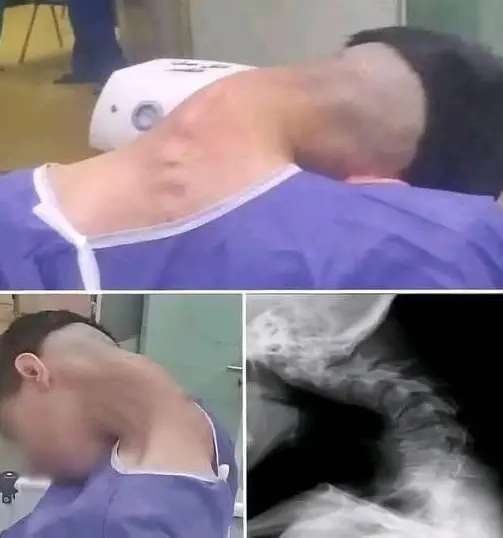
Introduction: When One Moment Redefines Everything
In September 2022, a fatal workplace injury involving an 18-year-old laborer in India sent shockwaves through the medical and occupational safety communities. What initially appeared to be a devastating, though tragically common, trauma case quickly turned into something much more profound: a spinal fracture so rare it defies classification, and a situation so preventable it serves as a haunting reminder of what can go wrong in a moment of oversight.
The worker was struck on the forehead by a heavy metallic object—a scenario that might suggest a concussion or facial injury. But what unfolded next was catastrophic. He collapsed immediately, experienced severe respiratory distress, and died within 48 hours. A post-injury CT scan revealed a unique biomechanical failure in his cervical spine, one that no current spinal trauma system could categorize.
This case stands at the intersection of orthopedic rarity and workplace tragedy. It challenges the adequacy of existing diagnostic models, exposes safety gaps in industrial environments, and reinforces the hard truth that emergency medicine, no matter how fast or skilled, cannot always undo what has already gone wrong.
The Incident: A Routine Day Turned Fatal
On the day of the incident, the young laborer was performing standard duties on a worksite. Without warning, a heavy metallic pipe or beam—possibly part of overhead scaffolding or structural equipment—fell from a height and struck him squarely on the forehead. The unusual point of impact, unlike the more typical top or back of the skull in industrial accidents, played a critical role in the outcome.
Witnesses reported an immediate loss of consciousness. Within minutes, he began showing signs of:
Respiratory failure
Shock
Hemodynamic instability
Emergency responders acted swiftly. The patient was:
Intubated on site
Fitted with a rigid cervical collar
Transported to a nearby trauma center
Despite aggressive supportive care—including ventilation and traction—his condition deteriorated. He died 48 hours later. But it was the postmortem imaging that truly stunned medical professionals.
The Injury: A Spinal Fracture Without Precedent
Non-contrast CT imaging of the cervical spine showed:
Retropulsion fracture of the C5 vertebral body, meaning the vertebra collapsed inward toward the spinal canal
Fracture of the posterior-superior portion of C6
No involvement of the facet joints or pedicles, which are typically compromised in high-energy cervical spine injuries
This configuration created a “nutcracker” effect, where the C5 vertebra was crushed between adjacent segments, forcing bone fragments into the spinal canal and causing immediate spinal cord compression.
Why It’s Medically Significant
The injury didn’t conform to any major classification systems, including:
Allen & Ferguson
SLIC-S (Subaxial Cervical Spine Injury Classification)
AO Spine Classification System
This highlights a major gap: our current diagnostic tools were not designed for this pattern of trauma, making it difficult to guide treatment or predict prognosis in rare cases like this one.
Biomechanical Analysis: What Made This Injury Unique?
The subaxial cervical spine (C3–C7) is responsible for the majority of neck mobility—but with that flexibility comes vulnerability. In most cervical spine trauma cases, injuries are caused by:
Hyperflexion or hyperextension
Axial loading from the top
Lateral or rotational impact
However, in this case, the force was applied directly to the forehead, generating a downward and slightly posterior vector. This caused:
Axial compression through the anterior column
Central collapse of the C5 vertebra
Posterior displacement of bone into the spinal canal
No ligaments were torn, and no dislocations were present, making this a pure flexion-compression injury with mid-column failure—something exceedingly rare in cervical trauma.
Emergency Medical Response and Outcome
Upon hospital admission:
The patient required full ventilator support
He exhibited no motor function or reflexes below the neck
Hemodynamic parameters remained unstable despite fluid resuscitation and vasopressors
Imaging confirmed spinal cord compression, but the severity and instability ruled out surgical intervention
Despite maximal supportive care, including cervical traction and respiratory management, the patient succumbed to irreversible neurogenic shock and multi-organ failure.
What This Case Teaches Us
This tragedy offers critical lessons across three domains: workplace safety, medical diagnostics, and emergency response limitations.
1. The Fragility of Workplace Safety
This death occurred not because of complex machinery failure, but because of a single unsecured object. In high-risk environments—especially construction, shipping, or factory zones—basic safety protocols must be enforced:
Use of overhead safety nets or barriers
Proper storage and securing of heavy materials
Strict adherence to hardhat use policies
Regular site inspections for fall hazards
A lapse in any of these can turn a safe workspace into a death trap.
2. Inadequacy of Current Spine Injury Classifications
While systems like SLIC-S or AO Spine are widely used, they fail to accommodate highly atypical patterns. Without flexible diagnostic tools, clinicians may miss or misinterpret trauma types that fall outside traditional frameworks.
This case underscores the urgent need for:
Case-driven updates to classification models
Integration of rare trauma patterns into trauma education
Improved algorithms for spinal cord injury risk assessment
3. Emergency Medicine Has Limits
This case is not a failure of the trauma system—it’s a reminder of its boundaries. Even with:
Rapid airway management
On-site immobilization
Hospital-level neurocritical care
The body cannot always recover from instant, irreversible spinal cord trauma. Prevention is, and always will be, more effective than cure in such cases.
Preventive Takeaways: Safety Begins Before the Fall
For Workplaces:
Never store or transport heavy objects above head height without physical restraints
Mandate safety helmet use in all industrial zones
Train all staff in hazard recognition, not just managers or supervisors
Conduct fall-risk audits of all elevated storage and load-bearing platforms
For Medical Professionals:
Maintain a high index of suspicion in cases of vertical or frontal head impact
Don’t dismiss spinal trauma if posterior elements appear intact
Use both CT and MRI when feasible for a full picture of spinal injury
Share unusual cases through medical literature to help expand diagnostic frameworks
Conclusion: A Young Life, a Lasting Legacy
This young man’s death was not just the result of a unique spinal injury—it was the outcome of a preventable oversight. His case now serves as a crucial data point in spine trauma research, a warning to industrial safety regulators, and a call to action for improved trauma classification systems.
In medicine, anomalies matter. In safety, complacency kills. And in both worlds, we owe it to every patient and every worker to be better prepared.
Because behind every rare case and every workplace fatality is a person who didn’t come home.




